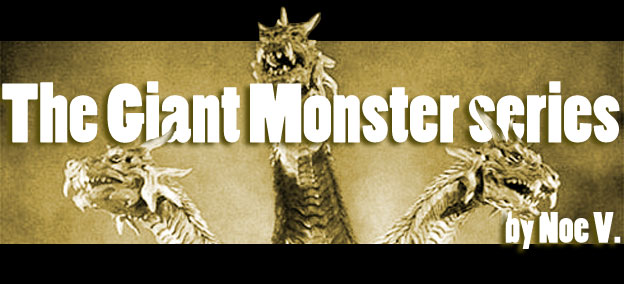
The giant monster games mentioned thus far had a common theme. They were all about fighting against the creatures or simply trying to survive against them. The draw for gamers was the fear and excitement that they felt battling them. There was a different type of emotional draw that could only be had by playing as the giant monster. In order to do this the game developers had to create new ways to experience the game. Giant monsters were not human and did not have the same limitations as them. The creatures could be as benevolent or malevolent as the designers allowed. In some genres the giant monster was considered a god simulation. Spore, Sim City and the classic Populous were examples of the god simulation or life simulation games.
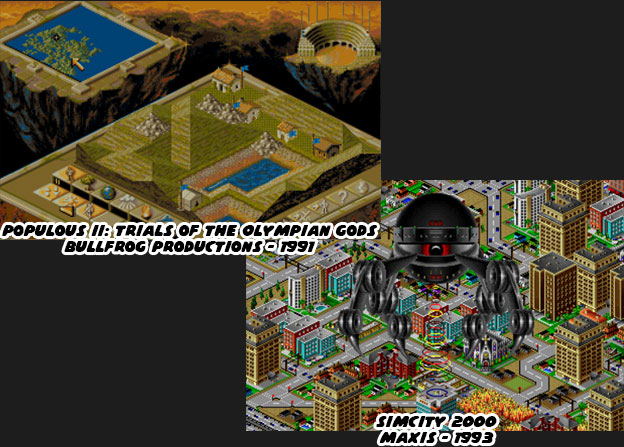
Players assumed the role of an invisible creator and could build life and architecture from the microscopic to the a global scale. To make things interesting players could trigger catastrophic events, or learn how to deal with them. Floods, alien invasions, giant lizard attacks and earthquakes were among the more unique game play elements. The invisible forces could build or destroy an entire civilization and because they could they would sometimes be worshiped by the in game characters. Such was the case for Doshin the Giant, a 1999 classic Nintendo Gamecube. Doshin was different from all the other simulation games because the character and his actions were not invisible. Players assumed the role of Doshin and tried to help the natives on the island of Barudo. The banana-colored Doshin could help shape the land for villagers, aid in the recovery from natural disasters and make their lives a little easier. As such he was asked to help unite the four tribes through his powers. The more he did for the islanders the larger and more powerful he became. Players could also turn on the villagers and become a destructive giant, Doshin would turn red and grow bat wings. He was known then as Joshin. In other simulation games players could become more powerful, only they never saw an on screen persona that represented themselves.
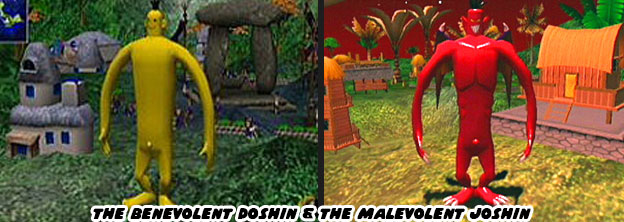
In 2001 Planet Moon Studios released a title whose plot was comparable to Doshin but whose gameplay was completely different. Giants: Citizen Kabuto was set on an island as well except this piece of land was traveling through space. On it three different races were battling for supremacy. Two of the races, the Meccaryns and Sea Reapers fought with weapons and magic respectively. Players could play as either of those races in a third-person perspective. The third race consisted of a single creature, a giant name Kabuto. Having control over Kabuto was a powerful contrast to the other races. The game played similar to other third person shooters except for Kabuto. The character towered over entire units and plowed though their ranks with ease. Kabuto did not have any weapons but instead relied on wrestling moves to damage opponents and their bases. The sense of power generated by Kabuto was great. When he ran he knocked over trees with ease. The other races could get flattened like insects every time he swung his massive arms. The game play was a stark contrast to Doshin, whose slow pace and friendly atmosphere felt more childlike and innocent. Apparently there was a difference between the video game gods.
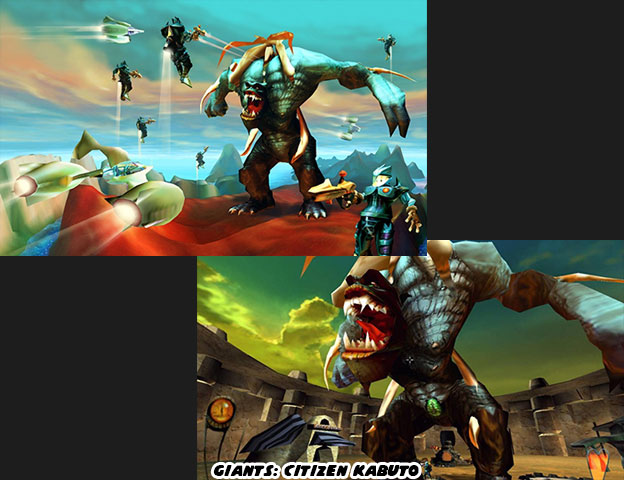
A third type of giant monster god was heating up the charts in 1994. Atari used the popularity of the fighting game as the basis for Primal Rage. The game was set in a dystopian future where giant creatures were battling for control of the planet. Each of the Primal Rage characters was worshipped as a god; the god of life, the god of virtue, the god of decay, the god insanity, etc. The monsters created for the game took a page from the oldest of the giant monster heroes. Every character featured in the game was created from a clay, rubber and fur armature just like the 1933 King Kong model. The animators used similar stop-motion techniques to create the frames for the game. Instead of posting those frames to film they were digitized to video and sprites were created for the programmers to use. Model backgrounds were composited over digital paintings to create the levels. Actors in caveman costumes were also recorded to create the people worshipping the monsters on each level. These tiny humans would follow their god from level to level, growing in number as the player progressed. The monsters could snatch a human from the background and eat them for a health bonus.
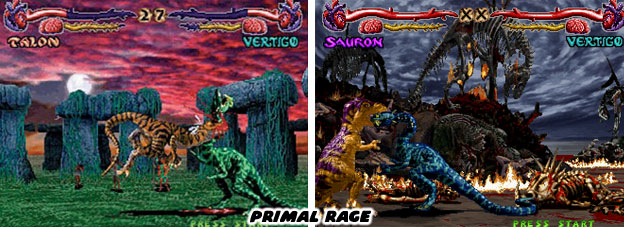
The Primal Rage monsters blew the doors off the fighting genre. Up until then fighting games featured human-sized characters with traditional or fictional martial arts moves. The Primal Rage avatars could have easily snacked on the fighters from other games. When they battled they shook the ground and created natural disasters. The developers experimented with command inputs. Like Mortal Kombat (1992) and Killer Instinct (1994), the studios were trying to create controls that differed from the six button and joystick commands that Capcom had popularized in the Street Fighter series. For Primal Rage special attacks were activated when the player released the buttons rather than when they pressed them, making for a unique learning curve. The game was also the first title that I had ever seen that allowed infinite combos, a precursor to the combos that made the Capcom VS series so popular. The fights of the Primal Rage avatars were brutal and offered players a chance to kill an opponent at the end of a match. The fatalities in Primal Rage were every bit as brutal if not more so than those in Mortal Kombat. Monsters could literally punch the brains out of opponent skulls and eat the flesh off their bones. Arcade goers winced at some of the more gross acts players could perform. Some would argue that Atari crossed the line when they introduced a character that farted, vomited and even urinated on his opponents.
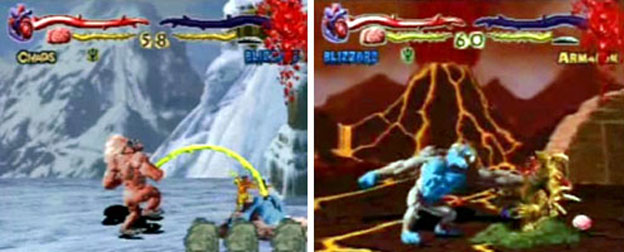
Allowing gamers to play as gods had gone to the head of developers. After all, up until that point most genres tried to create the action for human-scaled characters. Racing, shooting, role-playing titles all tried to create worlds that were believable for human protagonists. All of a sudden the developers found themselves creating worlds for monsters that were the top of the food chain. No natural creature or man made weapon could have stood up to the biggest of the Primal Rage characters. They could be as gross or violent as they wanted to because there was no one that could have stopped them.
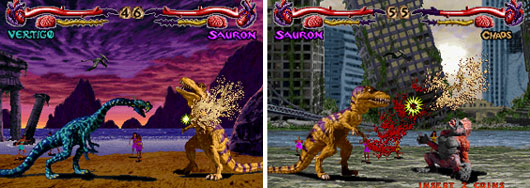
Well, the only thing that could have stopped them would have been a bigger and badder monster. Necrosan was the god of death. It was a dragon-like creature that was mostly bones but with portions of muscle and even intestine still attached to the skeleton. Players would have to defeat the creature had they wanted to claim the "Urth." Sadly the final battle was never realized. The arcade game had been published without an actual final boss. In fact it was released with unbalanced gameplay, known bugs and glitches. Patches were released over the months to arcade owners to help fix the controls and balance the fighters. Developers were hoping to introduce an actual final boss via an upgrade. Unfortunately development of that final boss and his official inclusion in a sequel was cancelled. It was proving to be too costly for Atari to continue supporting the series. The only known images of Necrosan were from concept art, sprites for the unpublished Primal Rage II, a comic book and a toy released before Atari pulled the plug. Those gods seemed to have limitations after all.
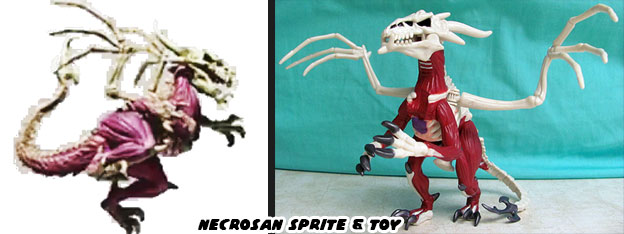
The giant monster offered unique game play opportunities for existing genres. They could enhance the sim, RPG, FPS or fighting game more than any weapon or magical attack could. Developers were finding it hard to create a niche for the giant monsters themselves. What many developers missed were lessons from their own history. Two studios showed what format worked best for the giant monster back in 1986. They created a template that would work again and again. The studios that paid attention to the model would achieve a certain level of success. The next blog will talk about the year that changed everything.
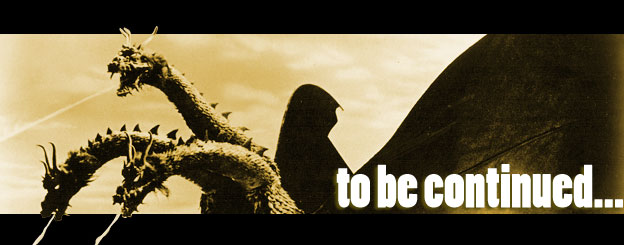
No comments:
Post a Comment